With its 33 acres of gardens and an arboretum overlooking Narragansett Bay in the historic port of Bristol, Rhode Island, Blithewold is an exceptional example from the era of the American Country Place. The graceful estate was in the late 1890s a summer home for coal magnates Bessie and Augustus Van Wickle of Hazleton, Pennsylvania. The waterfront property had formerly belonged to international banker John Rogers Gardner, who in the 1860s had begun landscaping in the style of an English country estate, adding meandering gravel paths, exotic specimen trees, and a greenhouse, where he grew orchids and roses.
Like many wealthy industrialists of the time, Augustus Van Wickle sought out a healthful seaside retreat for his family; to that end, he visited an old college friend in Rhode Island in 1893. Upon arrival, Van Wickle rather impulsively purchased a 78-foot steam yacht from the renowned Herreshoff boat firm in Bristol. Realizing he would need a place to dock it, he went to see the John Gardner property. Augustus immediately sent for his wife, Bessie, who, being a passionate gardener, fell in love with the place.
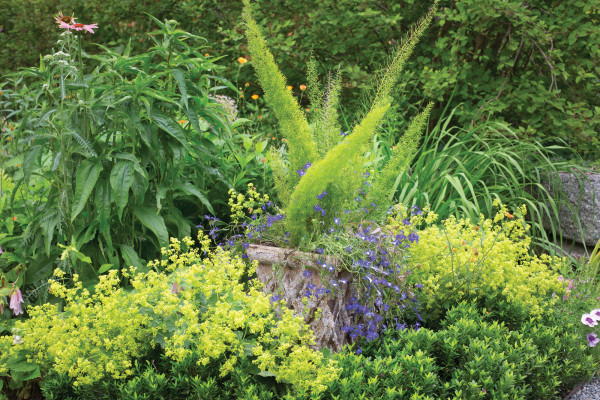
A container is planted with Allium ‘Pinball Wizard’, a foxtail fern (Asparagus densiflorus ‘Myersii’), blue lobelia, and echinacea.
Gross & Daley
After acquiring the property, the Van Wickles erected a shingled Queen Anne-style home for themselves, naming it Blithewold, Old English for “happy woodland.” They set out to enhance the existing grounds and gardens, hiring the landscape architect John DeWolf.
DeWolf, who belonged to one of Bristol’s oldest families, was working with the Olmsted firm in New York City, commuting to superintend the creation of Prospect Park in Brooklyn. He and Bessie Van Wickle collaborated on the Blithewold garden design until DeWolf’s death in 1913, adding “a series of gardens ranging in character from mysterious to exotic and from poetic to practical.”
The two consciously employed an informal, natural approach, one that was more in the Arts & Crafts vein and unlike the formal, hedged gardens of Gilded Age estates in nearby Newport. Intimate rather than grand, their new garden design fit harmoniously into the existing landscape and was allowed to evolve.
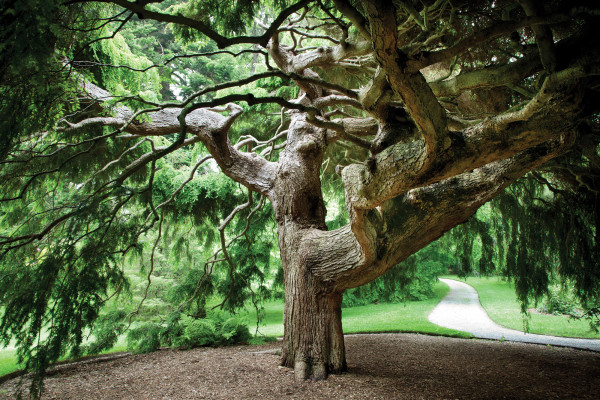
Blithewold’s trees have attracted attention since John Gardner planted many exotics starting in the mid-1800s. This is a weeping hemlock, Tsuga canadensis ‘Pendula’.
Gross & Daley
To start, DeWolf laid out a 10-acre Great Lawn, creating a gently undulating terrain from the house down to the bay. Here the extended family bowled and played croquet and lawn tennis. A dock for the new yacht was built at the water’s edge, and a beach was created with sand imported from Martha’s Vineyard.
Augustus Van Wickle was not fortunate enough to enjoy his pleasure grounds for long; he was killed in 1898 in a skeet-shooting accident, leaving Bessie and her daughters, Marjorie and Augustine, the latter born five months after her father’s death.
Bessie soon married a family friend, the Boston clothier William McKee, but only a few years later the Queen Anne house was destroyed by fire. She and McKee rebuilt—this time a hefty English manor house of stone.
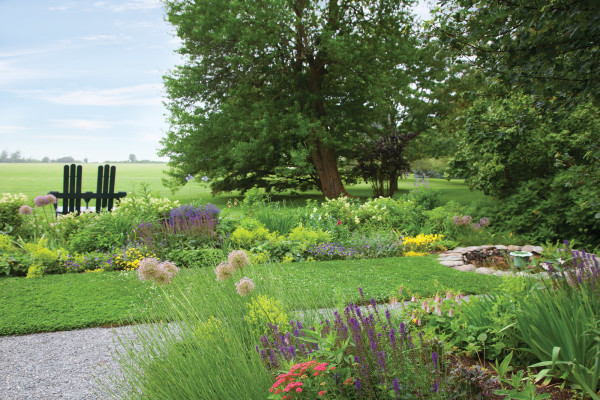
The North Garden’s fountain is embedded in a stone wall; it spurts water out of an ornamental mask into a shell basin placed there in 1912. On either side of the fountain, stone steps curve down from the verandah.
Gross & Daley
Carefully placed about the grounds are unique specimen trees, now mature, including weeping specimens of beech, sophora, and Sargent’s hemlock. A Chinese toon tree (Cedrela sinenis) was much admired by eminent botanists visiting from Boston’s Arnold Arboretum in 1926. A giant sequoia now soars to 90 feet. DeWolf raised it from a seedling in the greenhouse at Prospect Park, transporting it to Blithewold by train when it got too tall for indoors.
The last Van Wickle descendent, Marjorie Lyon, was in residence until 1976, and left the entire estate to the Heritage Trust of Rhode Island. Today, dedicated volunteers take the place of the 14 or more gardeners the family employed in the past.
Thanks to the tireless visionaries of groups such as Save Blithewold Inc. and The Garden Conservancy, this extraordinary treasure that nearly fell to developers in the 1990s is now preserved for everyone’s enjoyment.
The North Garden at Blithewold Gardens
The most formal of the Blithewold gardens, the North Garden is a sunken area adjacent to the main house. Owner Bessie Van Wickle and designer John DeWolf used local stone in the dry-laid stone walls that contain the garden; they included a wall fountain with a whimsical mask that spurts water into a marble shell basin. They also installed a North Star in a stone wall, a nautical motif that had been salvaged from the north tower of the earlier mansion after the fire.
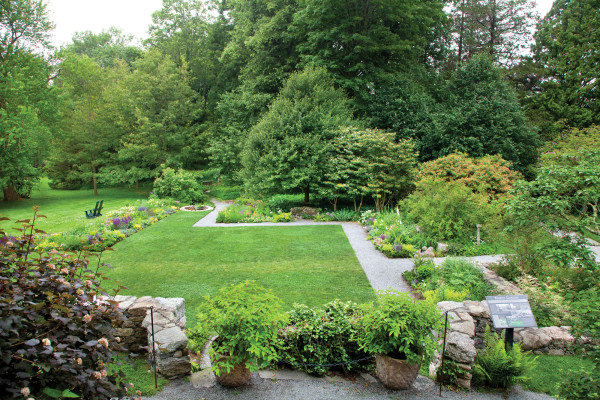
The North Garden was earlier referred to as the Sunken Garden. With deep borders, ornamental stonework, a fountain, and a small garden pool, it is the most formal of Blithewold’s gardens.
Gross & Daley
The North Garden’s deep borders are interlaced with billowing perennials and flowering shrubs planted in a Gertrude Jekyll manner to achieve a painterly effect of harmonies and contrasts in colors and textures. Viewed from the verandah of the house, the North Garden layout has asymmetrical lines that are a bit quirky, fading away at its edge into a shady, woodsy area that blooms with thousands of daffodils in spring.
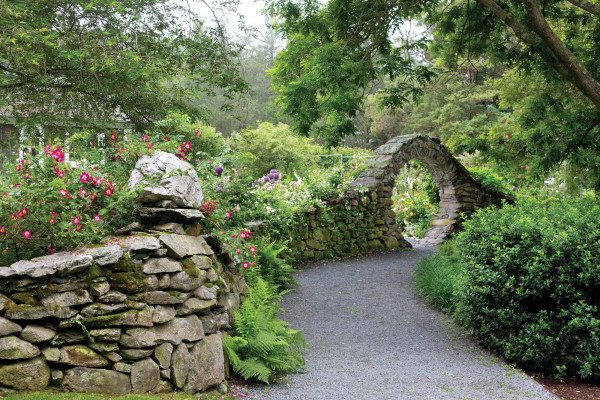
A gravel path meanders from the main house to the Moon Gate of the Rose Garden.Exuberant, rambling Rosa ‘American Pillar’ spills over the stone walls built to contain the garden.
Gross & Daley
The Rose Garden
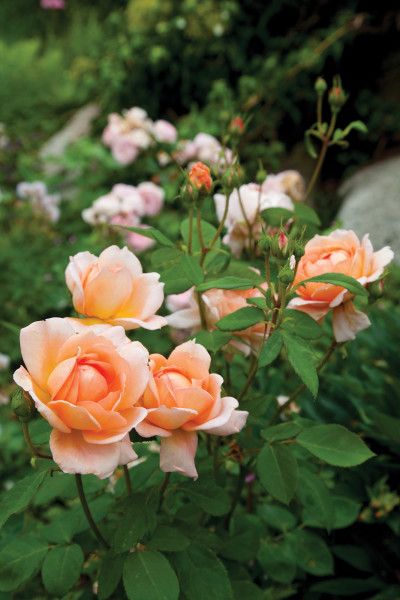
The Rose Garden also includes newer David Austin hybrids such as the deeply cupped, coppery ‘Pat Austin’.
Gross & Daley
Hidden away from the main house, in an area that had been the laundry-drying yard, a formal Rose Garden was planted, filled with climbing roses on arched walkways and mixed with colorful beds of foxgloves, peonies, violas, and alliums. DeWolf designed the elegant, Asian-inspired Moon Gate built from stone, which became a welcoming portal to the secluded area. Still thriving in the Rose Garden today is a very large and ancient, pink Chestnut Rose. It is believed that Bessie Van Wickle brought it back from Washington’s Mount Vernon at a time when the Ladies’ Association there was selling cuttings to help raise funds to restore the rundown home of the former President.
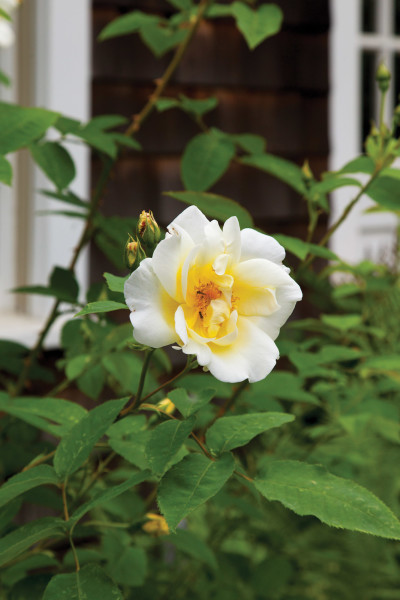
Rosa ‘Wind-rush’ is a modern English shrub rose with semi-double, soft-yellow blooms.
Gross & Daley
Bessie was quite knowledgeable about horticulture, and liked to get her hands dirty working in the garden with her daughters and also her sisters, who visited in summer. Along with her companion, Estelle Clements, Bessie worked in the beds, deadheading roses and keeping careful notes on the garden’s progress. Later, her daughter Marjorie Lyon would tour European estates, where she gathered ideas for adding to the garden after her mother’s death.
Many thanks to horticulturist Gail Read of Blithewold Garden.







